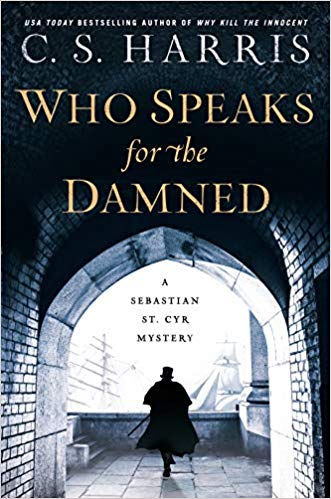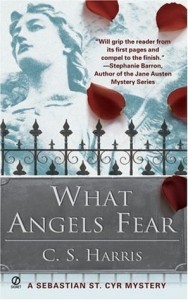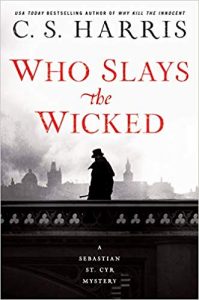 Who Speaks for the Damned (Sebastian St. Cyr, #15)
Who Speaks for the Damned (Sebastian St. Cyr, #15) by
C.S. Harris Format: eARC Source: supplied by publisher via NetGalley Formats available: hardcover, ebook, audiobook
Genres: historical fiction,
historical mystery Series: Sebastian St. Cyr #15 Pages: 336
Published by Berkley on April 7, 2020
Purchasing Info: Author's Website,
Publisher's Website,
Amazon,
Barnes & Noble,
Kobo,
Bookshop.org Goodreads Sebastian St. Cyr investigates the mysterious life and death of a nobleman accused of murder in this enthralling new historical mystery from the USA Today bestselling author of Why Kill the Innocent....
It's June 1814, and the royal families of Austria, Russia, and the German states have gathered in London at the Prince Regent's invitation to celebrate the defeat of Napoléon and the restoration of monarchical control throughout Europe. But the festive atmosphere is marred one warm summer evening by the brutal murder of a disgraced British nobleman long thought dead.
Eighteen years before, Nicholas Hayes, the third son of the late Earl of Seaford, was accused of killing a beautiful young French émigré and transported to Botany Bay for life. Even before his conviction, Hayes had been disowned by his father. Few in London were surprised when they heard the ne'er-do-well had died in New South Wales in 1799. But those reports were obviously wrong. Recently Hayes returned to London with a mysterious young boy in tow--a child who vanishes shortly after Nicholas's body is discovered.
Sebastian St. Cyr, Viscount Devlin, is drawn into the investigation by his valet, Jules Calhoun. With Calhoun's help, Sebastian begins to piece together the shattered life of the late Earl's ill-fated youngest son. Why did Nicholas risk his life and freedom by returning to England? And why did he bring the now-missing young boy with him? Several nervous Londoners had reason to fear that Nicholas Hayes had returned to kill them. One of them might have decided to kill him first.
My Review:
Once upon a time, the author of the Sebastian St. Cyr series described how she came to write St. Cyr and his series. She said that she wanted to create a character who seemed, on the surface, to be the epitome of the Regency hero; tall, dark, handsome and brooding. (I think with emphasis on the brooding.) But then to explicitly NOT make him the hero of a Regency romance. Thus was Sebastian St. Cyr, Viscount Devlin, born.
A much later description of Devlin referred to him as Darcy with more than a touch of James Bond, but that doesn’t really feel right. St. Cyr seems to have always been carrying too much emotional baggage to have ever been Darcy, while his adventures and investigations take him into much darker places than Bond usually goes and afford him considerably fewer technological toys – even ones that would have existed in the Regency.
St. Cyr relies on his instincts, his brains and his considerable ability to fight as dirty as necessary, whether that fight involves fisticuffs, social exposure or politics – as much as he hates the latter options when needed.
 When his story began in 2005 – or in 1811 in St. Cyr’s world, England was on the brink of the Regency and St. Cyr was a battle-scarred veteran of the Napoleonic Wars, unable to settle or sleep, wracked with PTSD after his life-altering experiences in a war that had not yet ended. (Even by the time period of this 15th book in the series, 1814, the war is still not over. It is merely in abeyance during Napoleon’s exile on the island of Elba.)
When his story began in 2005 – or in 1811 in St. Cyr’s world, England was on the brink of the Regency and St. Cyr was a battle-scarred veteran of the Napoleonic Wars, unable to settle or sleep, wracked with PTSD after his life-altering experiences in a war that had not yet ended. (Even by the time period of this 15th book in the series, 1814, the war is still not over. It is merely in abeyance during Napoleon’s exile on the island of Elba.)
St. Cyr, as the heir to an earldom, should be one of the Regency dandies that appear in the pages of so many romances set in the period. Instead, he has become an unofficial and unpaid murder investigator with the help of the head of the newly formed police agency at Bow Street. His membership at the highest levels of the aristocracy allows him to poke his nose into many, many places where a simple copper would be thrown out the back door.
Even his father-in-law, the Prince Regent’s cousin and spymaster Jarvis, is forced to deal with St. Cyr whether he likes it or not. And he definitely does not.
This latest entry in the series is an enthralling mystery that does an especially good job of exposing the glitter of the Regency Era as the bio-luminescence of something rotting in the dark, as St. Cyr finds himself investigating the death of a man who is all too much like the one that he sees in his own mirror. There but for the grace of god, and just a few scraps of luck that turned good instead of bad, would have gone St. Cyr.
It’s a case he can’t let go of, no matter how many times he’s warned off. And no matter how high the halls of power that he needs to bring low.
Escape Rating A+: It should be fairly clear that this is one of my favorite series. In fact, if it isn’t clear already, as part of my Blogo-Birthday Celebration I ONLY review stuff I really, really love. After all, this is my birthday and the blog’s birthday and why shouldn’t I treat myself to some books and authors that I know I’ll love?
Especially since this whole week is a hobbit’s birthday, meaning that I give presents instead of getting them. It just wouldn’t do to give away books I don’t utterly adore.
What I love about this series in general, and it’s certainly exemplified by this entry, boils down to two things. One is certainly the development of the characters. St. Cyr and his wife Hero have created a partnership of equals in a way that doesn’t often happen in historical romance. They have both come through dark places and dark things, and found each other in spite of people and circumstances that stood in their way.
They both carry a lot of baggage, and it is not a weight that either can carry FOR the other. Rather, carrying it together lightens the load. I also have to say that more than either Darcy or Bond, the character that St. Cyr most often reminds me of is Roarke from the In Death series. They share the same kind of darkness in their pasts, and they both work on expiating their demons in the same ways. They have also both formed strong partnerships with women who were initially on opposing sides from themselves.
 The other thing that makes this series so strong is its setting. It is so much the opposite of what we think of the Regency as being. There was so much glitter at the top, and so much rot underneath. The murder in this story is a case in point. The powers-that-be have already decided who MUST be guilty, regardless of who is actually guilty. The attitudes reflected by our protagonists resonate with 21st century readers and yet feel part and parcel of their time and place.
The other thing that makes this series so strong is its setting. It is so much the opposite of what we think of the Regency as being. There was so much glitter at the top, and so much rot underneath. The murder in this story is a case in point. The powers-that-be have already decided who MUST be guilty, regardless of who is actually guilty. The attitudes reflected by our protagonists resonate with 21st century readers and yet feel part and parcel of their time and place.
Wrong is always wrong. Murder is always murder. No matter who the victim was, or what they, themselves might have done. That St. Cyr sees so much of himself in this particular victim adds to the poignancy of the whole story.
In the end, good triumphed, at least temporarily. Evil got its just desserts. And the powers that be blame St. Cyr for righting a wrong that many would have preferred to bury. A combination of things as they should be with the acknowledgement that many in power do not desire that outcome.
While I am eagerly awaiting St. Cyr’s next case, probably this time next year, I’m offering one lucky reader the chance to either begin this marvelous series or pick up wherever they might have left off. This is a series where you do need to at least start at the beginning. I read the first few, lost track of the series in the middle and have returned for the last several and have enjoyed every single one since I returned.
I hope that the winner of this giveaway will too.
a Rafflecopter giveaway












































 Who Speaks for the Damned (Sebastian St. Cyr, #15) by
Who Speaks for the Damned (Sebastian St. Cyr, #15) by  When his story began in 2005 – or in 1811 in St. Cyr’s world, England was on the brink of the Regency and St. Cyr was a battle-scarred veteran of the Napoleonic Wars, unable to settle or sleep, wracked with PTSD after his life-altering experiences in a war that had not yet ended. (Even by the time period of this 15th book in the series, 1814, the war is still not over. It is merely in abeyance during Napoleon’s exile on the island of Elba.)
When his story began in 2005 – or in 1811 in St. Cyr’s world, England was on the brink of the Regency and St. Cyr was a battle-scarred veteran of the Napoleonic Wars, unable to settle or sleep, wracked with PTSD after his life-altering experiences in a war that had not yet ended. (Even by the time period of this 15th book in the series, 1814, the war is still not over. It is merely in abeyance during Napoleon’s exile on the island of Elba.) The other thing that makes this series so strong is its setting. It is so much the opposite of what we think of the Regency as being. There was so much glitter at the top, and so much rot underneath. The murder in this story is a case in point. The powers-that-be have already decided who MUST be guilty, regardless of who is actually guilty. The attitudes reflected by our protagonists resonate with 21st century readers and yet feel part and parcel of their time and place.
The other thing that makes this series so strong is its setting. It is so much the opposite of what we think of the Regency as being. There was so much glitter at the top, and so much rot underneath. The murder in this story is a case in point. The powers-that-be have already decided who MUST be guilty, regardless of who is actually guilty. The attitudes reflected by our protagonists resonate with 21st century readers and yet feel part and parcel of their time and place.
